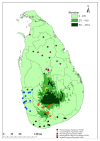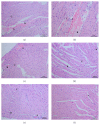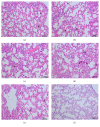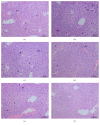The Venom of Spectacled Cobra (Elapidae: Naja naja): In Vitro Study from Distinct Geographical Origins in Sri Lanka
- PMID: 30363742
- PMCID: PMC6180993
- DOI: 10.1155/2018/7358472
The Venom of Spectacled Cobra (Elapidae: Naja naja): In Vitro Study from Distinct Geographical Origins in Sri Lanka
Abstract
Several countries residing envenomation due to Naja naja had revealed a disparity in the venom composition according to their geographic location and Sri Lankan cobra still lacks the evidence to support this. Therefore, the current study was focused on addressing relationship between the histopathological changes according to geographic variation of Sri Lankan N. naja venom. The histopathological changes in vital organs and muscle tissues following intramuscular administration of venom of N. naja were studied using BALB/c mice. The median lethal dose of venom of N. naja in the present study was determined to be 0.55, 0.66, 0.68, 0.62, and 0.7 mg/kg for North (NRP), Central (CRP), Western, Southern, and Sabaragamuwa Regional Population venoms, respectively. Histopathological changes were observed in different levels in vital organs and muscle tissues of mice. NRP accompanied significantly higher infiltration of inflammatory and necrotic cells into skeletal muscle and CRP venom demonstrated high level of cardiotoxic effects comparing to other regions. This study revealed a certain extent of variations in the pathological effects of N. naja venom samples according to their geographical distribution.
Figures









Similar articles
-
Elucidating the Venom Diversity in Sri Lankan Spectacled Cobra (Naja naja) through De Novo Venom Gland Transcriptomics, Venom Proteomics and Toxicity Neutralization.Toxins (Basel). 2021 Aug 10;13(8):558. doi: 10.3390/toxins13080558. Toxins (Basel). 2021. PMID: 34437429 Free PMC article.
-
Systemic pathological effects induced by cobra (Naja naja) venom from geographically distinct origins of Indian peninsula.Exp Toxicol Pathol. 2010 Nov;62(6):587-92. doi: 10.1016/j.etp.2009.08.002. Epub 2009 Sep 3. Exp Toxicol Pathol. 2010. PMID: 19733040
-
Elucidating the biogeographical variation of the venom of Naja naja (spectacled cobra) from Pakistan through a venom-decomplexing proteomic study.J Proteomics. 2018 Mar 20;175:156-173. doi: 10.1016/j.jprot.2017.12.012. Epub 2017 Dec 24. J Proteomics. 2018. PMID: 29278784
-
A comparative study of venomics of Naja naja from India and Sri Lanka, clinical manifestations and antivenomics of an Indian polyspecific antivenom.J Proteomics. 2016 Jan 30;132:131-43. doi: 10.1016/j.jprot.2015.10.007. Epub 2015 Oct 24. J Proteomics. 2016. PMID: 26506536
-
Variations in biochemical and pharmacological properties of Indian cobra (Naja naja naja) venom due to geographical distribution.Mol Cell Biochem. 2002 Jan;229(1-2):93-101. doi: 10.1023/a:1017972511272. Mol Cell Biochem. 2002. PMID: 11936852
Cited by
-
Anti-snake venom and methanolic extract of Andrographis paniculata: a multipronged strategy to neutralize Naja naja venom acetylcholinesterase and hyaluronidase.3 Biotech. 2020 Nov;10(11):476. doi: 10.1007/s13205-020-02462-4. Epub 2020 Oct 15. 3 Biotech. 2020. PMID: 33083200 Free PMC article.
-
The timing is right to end snakebite deaths in South Asia.BMJ. 2019 Jan 22;364:k5317. doi: 10.1136/bmj.k5317. BMJ. 2019. PMID: 30670457 Free PMC article.
-
Naja mossambica mossambica Cobra Cardiotoxin Targets Mitochondria to Disrupt Mitochondrial Membrane Structure and Function.Toxins (Basel). 2019 Mar 8;11(3):152. doi: 10.3390/toxins11030152. Toxins (Basel). 2019. PMID: 30857180 Free PMC article.
-
Assessing the Efficacy of Monovalent and Commercialized Antivenoms for Neutralizing Moroccan Cobra Naja haje Venom: A Comparative Study.Trop Med Infect Dis. 2023 Jun 2;8(6):304. doi: 10.3390/tropicalmed8060304. Trop Med Infect Dis. 2023. PMID: 37368722 Free PMC article.
-
Evaluation of the properties of Bungarus caeruleus venom and checking the efficacy of antivenom used in Bangladesh for its bite treatment.Toxicon X. 2023 Jan 3;17:100149. doi: 10.1016/j.toxcx.2023.100149. eCollection 2023 Mar. Toxicon X. 2023. PMID: 36654657 Free PMC article.
References
-
- World Health Organization, WHO Guidelines for the Production, Control and Regulation of Snake Antivenom Immunoglobulins. World Health Organization, Geneva. 2010. http://www.who.int/bloodproducts/snake_antivenoms/snakeantivenomguide/en/
-
- Kasturiratne A., Pathmeswaran A., Fonseka M. M. D., Lalloo D. G., Brooker S., De Silva H. J. Estimates of disease burden due to land-snake bite in Sri Lankan hospitals. Southeast Asian Journal of Tropical Medicine and Public Health. 2005;36(3):733–740. - PubMed
-
- Kularatne K., Budagoda S., Maduwage K., Naser K., Kumarasiri R., Kularatne S. Parallels between Russell's viper (Daboia russelii) and hump-nosed viper (Hypnale species) bites in the central hills of Sri Lanka amidst the heavy burden of unidentified snake bites. Asian Pacific Journal of Tropical Medicine. 2011;4(7):564–567. doi: 10.1016/S1995-7645(11)60147-8. - DOI - PubMed
LinkOut - more resources
Full Text Sources
Research Materials
Miscellaneous

